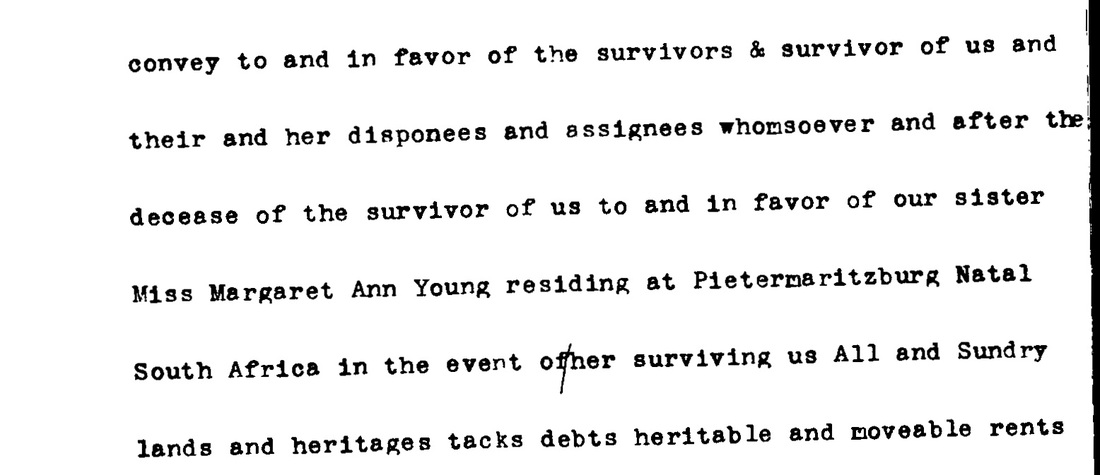'Trotting' about in Natal .... A Unicorn, A Couple of Christians, A Bishop & A Spot of Polo22/12/2013 IntroductionThis post started life as a simple Twitter post looking for information concerning South African records, specifically Natal. The post was answered almost immediately by fellow genealogist Kirsty Wilkinson, with some useful links and the suggestion I contact Rosemary Dixon-Smith. By mid morning I had enough information to post a short piece on Facebook, and by the end of the day the story of a long lost branch of the family was starting to emerge before me. My Christmas present to myself, a second hand copy of a book "Stories from the Karkloof Hills" by Charles Scott-Shaw lays bare in black & white the story of this and other remarkable emigrant families that had the foresight and guts to carve out a new life in the beautiful but challenging environment of the Karkloof, Natal in the 1850's. I could write at length of my findings contained within this lovely book, but for the sake of practicality I will limit this post to references to family members. As many of my relatives who read this post will know, our line is directly descended from Christian Trotter of Kerchesters, but what many may not know is that George Trotter, the subject of this post, had a mother called Christian, who was also the daughter of a Christian Trotter (aunt of our Christian Trotter) of Kerchesters & her husband Henry Richardson. George's parents John Trotter & Christian Richardson were therefore first cousins. George was thus first cousin to my 2x great grandfather John Smith, the progenitor of the Smith family of Longhoughton. The importance of wills in researchIn researching part of my own family I have constantly hit a blank with George Trotter, farmer of Stacks in Carriden, Scotland and his family. They simply disappear sometime after 1841. Nothing unusual in this - they obviously emigrated, but where? Extensive trawling of Canadian, American, Australian and New Zealand records proved fruitless. I turned my focus to his wife's family Grace or 'Grizzel' Young daughter of Richard Young brewer in Cannongate Edinburgh. Again, although the family is very interesting Grace's siblings remained on the whole unmarried. Grace is named in her father's will along with a sister I had failed to pick up from the census - Jane. George Trotter is also mentioned in the left margin so I knew I was on the right track. A search for the will of Jane and her other unmarried sisters threw up some enlightening new evidence. Written in 1886 it is pretty standard stuff leaving everything to each other etc., then one line caught my eye with reference to sister Margaret Ann Young residing in Pietermaritzburg, Natal, South Africa. What on earth is a single woman doing in Natal in 1886? The answer of course, is simple - she went with George Trotter, her sister Grace & their family. From the scant South African records that exist I ascertained that indeed Margaret Ann Young and George Trotter are listed as emigrants between 1824 & 1857. The 'Byrne Settlers' & The UnicornThe total number of emigrants between the years 1824 & 1857 was just in excess of 2,800. Those that became known as the 'Byrne Settlers' form a proportion of that number. They emigrated to Natal in 20 ships between the years 1849 to 1851 under a land purchase scheme set up & run by J C Byrne & Co. Rosemary Dixon-Smith, a specialist in Natal history, confirmed that George Trotter, his wife Grace Young and four children had arrived by the Unicorn in Port Natal on 19th September 1850, also listed amongst the passengers was Margaret Ann Young. The ship had sailed from Liverpool of the 14th June with a large contingent of Scottish emigrants largely from one neighbourhood. An account from a book written by a fellow settler J D Clark describes some of the passengers of the Unicorn as follows:- "Although the ship sailed from Liverpool on 13 June 1850, most of the emigrants were from Scotland and from one neighbourhood, a fact noted by a reporter of the 'Cape Town Mail' when the ship reached the Cape in August 1850. She carried 257 passengers and was too big (946 tons) to be conveyed across the Bar at Durban. From my research on home shores I know that George was born on the 9th September 1796 at Newham in North Northumberland, was baptised by the Rev Mr Nichol at Warenford, and yet the above account states he gave his age as 48, rather than 51. There may be a reason for this. If he was indeed an emigrant to the Natal under what became known as the 'Byrne Settlers' scheme, he would have been a little too old at 51, the ideal age being 45 or under. His farming experience and a little 'massaging of the truth' may just have seen him qualify. We can also ascertain from this account that two of George & Grace's children must have died prior to the date of departure. The surviving offspring, all baptised at Carriden, Scotland are, Isabella Cramond Trotter b. 1831, Christian aka Christina Trotter b. 1833, Margaret Ann Trotter b. 1836 & John Trotter b. 1838. J C Byrne & Co - opportunist and bounder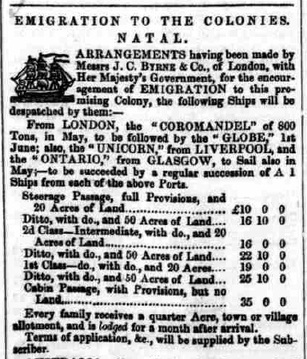 Joseph Charles Byrne was born in Dublin circa 1800, the son of a cattle dealer. He apparently travelled extensively throughout North America, Canada, Australia & New Zealand and wrote a number of guides for emigrants, although proof that he actually visited some of these countries is vague to say the least. Following his dismissal as a reporter of the Melbourne Argus in 1842 he made his way back to England in 1847 via the Cape Colony having borrowed £40 from a friend, and secured a prommissary note from his father. His next enterpise, a foray into the world of stocks & shares also proved unsuccesful, but the stock market crash proved the inspiration for his next business venture - the resultant mass emigration from the UK to the colonies. During the period 1846 to 1851 over 1.3 million people left the UK for foreign shores and Byrne wanted his slice of the action and Natal was his destination of choice. His first ship of 20 departed in January 1849 and by the time the fifth ship had docked at Port Natal there was already disgruntled murmurings amongst the earlier emigrants. In a nutshell it was the value of the land both monetary and productivity, that proved the major undoing of Byrne's scheme and by early September 1850, before the 'Unicorn' had docked at Durban, notices regarding the bankruptcy of J C Byrne & Co was appearing in the British newspapers.  Byrne then departed for Natal himself and a series of further swindles unfolded before Byrne departed Natal for good to try his hand at gold prospecting in Victoria, Australia. The failure of his scheme led to many hardships amongst the early settler and many sailed on to Australia themselves. Those that remained, of which George Trotter and his family were one, persevered and provided a significant contribution to the Natal of today. The information detailed above is abridged in the extreme. To read a fuller account of the life & times of Joseph Charles Byrne I would encourage you to read the excellent work of Dr Shelagh O'Byrne-Spencer whose life's work is dedicated to the history of these early settlers http://shelaghspencer.com/josephbyrne/ The family of George & GraceGeorge & Grace had settled and were established at the farm known as 'Woodside', Yarrow by the time of the marriage of their eldest daughters Isabella Cramond & Christian in 1853. George was also a Justice of the Peace. Christian's story... Christian was married to Charles Barter at Woodside in April 1853 in a double wedding with her sister Isabella Cramond to William Mackenzie. 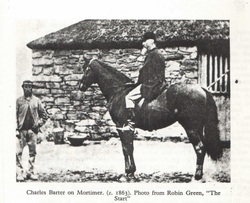 Christian was thrown from her horse and drowned just three months later. Scott-Shaw describes an excerpt from her husbands diary, written after he has decided to settle in the area, he describes his appreciation of the flora & fauna and his deep love for Christian thus:- "In deeply moving and very personal language he writes of his feelings during courtship, the encouragement of Miss Young, Mrs Trotter's sister, the simple wedding performed by Dean Green at Woodside, and the complete sense of harmony with nature and ecstasy as he drove off in his buggy with his lovely bride beside him to spend autumn days together at Singleton. His grief which was too deep and personal to describe ends his diary a few months later when Christian was tragically drowned". In an equally sensitive passage he describes her headstone and final resting place:- "Her name is still clearly marked on a tombstone, standing between two rushing streams at the foot of the M'Bona and looking wistfully down the Karkloof valley. It is leaning over at an angle, perhaps symbolic, of the forgotten glory of the struggle of those early settlers. Fate had decreed that she was not to live to see her family's descendants develop and populate this land of promise. Her husband and sisters were later to found the families who have played such an important role in the history of Midland Natal." Charles Barter married again in 1854, Emma Butler, and with private means was able to indulge in his love of horses and the chase. He was the first to import thoroughbred horses to the region, and not just any old horse but the famous stallion 'Mortimer' winner of the Ascot Stakes. He imported hounds too, and such was his passion for hunting he named his farms 'The Start', 'The Chase', 'The Check' and 'The Finish' A talented horseman he was the natural choice to command the Karkloof Carbineers & 1873 led his troops into the unknown territory of the "Giants's Castle Pass" against overwhelming odds. He died at the 'The Finish' in 1904, aged 84 years. Author Charles Scott-Shaw from his book "Stories from the Karkloof Hills" has this to say about this indomitable gentleman... "His introduction of thoroughbred horse breeding, game preservation, and his contribution to social and military life of the Karkloof will always mark him as one of her greatest sons" Isabella Cramond and the "Bishop"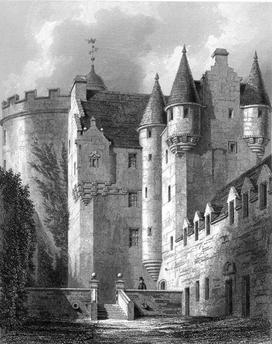 Midmar Castle Midmar Castle Married the same day at 'Woodside' was Christian's sister Isabella Cramond to William Mackenzie. William was the third son of William Mackenzie of Muirton & Mary Mansfield, daughter of James Mansfield of Midmar Castle, & granddaughter of the Earl of Stair. An illustrious and influential background for a graduate of Trinity Hall, Cambridge who was ordained and appointed chaplain to the Duchess of Sutherland. However this was not to last, and for reasons that remain a mystery he was ceremoniously "defrocked", a matter to which his family allegedly referred to with "pride and admiration". Whatever the cause William set out for a new life in Natal and was granted land in the Karkloof which he named 'Cramond'. A larger than life character he was affectionately nicknamed the "Bishop", who liked to make his presence felt on his trips to Maritzburg, often 'painting the town red'. His friend the Dean Green being on hand to get him home to bed and confiscating his boots to prevent further merry-making! 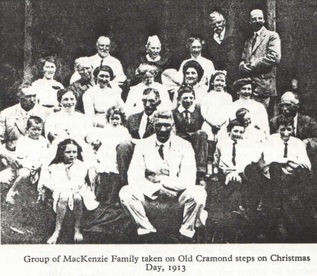 On a serious note he was an astute business man who prospered well at Cramond and was able to provide well for his large family. Their sons Harry & Tom were founder members of the Karkloof Polo Club, eldest son George settled at 'Buccleuch', daughter Mary Marion married Sir George Leuchars and in 1901 sons Alec, Jack, George & Tom, together with George Leuchars and Col. Green formed the Company 'The Clan Syndicate' that was to revolutionise farming in the Karkloof. Recognising the great potential for timber production, combined with the coming of the railway they set out to increase their land holding. They bought the farms of Etterick, & Japsons Vlei from John Trotter and also Roode Spruit, whilst maintaining their dairy and general farming interests . Scott-Shaw sums this chapter up by saying:- "The descendants of "Bishop" William Mackenzie and Isabella Trotter have multiplied to the fifth generation. Isabella's brother John inherited Yarrow and his son George continued farming after him, while his sister married Walter "Wattie" Shaw, whose father settled in the Karkloof at the same time as old George Trotter." Indeed "Wattie's" father Walter Thomas Shaw didn't just arrive at the same time as 'old' George Trotter, he arrived on the same boat! Mary Isabel & "Wattie" Shaw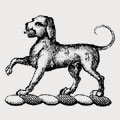 Shaw of Ardesley Shaw of Ardesley Mary Isobel Trotter married Walter Joseph Gower Shaw in 1900. "Wattie" as he was known was the son of Walter Thomas Shaw a descendant of Robert Shaw of Ardesley, Yorkshire who had been granted arms and crest by Queen Anne in 1707 & his wife Elizabeth Relph Gower. The Shaw family was however, originally of Scottish decent. 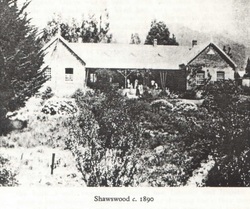 Wattie's father was one of four brothers, and of the three that married each had four sons. so already a large family in the making. After a few years at Shaw Flats, from where Whattie's father took a trip into Zulu country to trade for cattle and came back with 360 head four months later, the brothers established a sawmill at Clarendon now known as Shawswood, the birth place of Wattie & his brothers, and home to Shaw descendants to this day. Wattie was the eldest of four boys born in quick succession from 1871 to 1876 to be followed by two girls Caroline & Muriel in 1879 & 1881 respectively. Scott-Shaw tells us that they were "brought up in the best Victorian tradition, strict paternal rule." The brothers and their cousins all attended Hilton College where they excelled on the sports field, were members of the school rugby, cricket and rifle team. The youngest of the brothers, Campbell Gower Shaw was an exceptional sportsman and went on to represent Natal at rugby. An excerpt from a diary written in 1899 by a cousin holidaying at Shawswood gives a glimpse of the social side of everyday life, and the last sentence makes me smile :- "We young people, especially during weekends, used to go visiting at the various homes - 'Holbeck' where William Shaw lived, 'Yarrow' John Trotter's, 'Talavera' Eustace Shaw's, 'The Hutch' where Bunnie Burdon lived and ran that part of John Trotter's large estate and other places. Wattie spent most of his spare time at 'Yarrow' and also during the day supervising the erection of his home 'Colbourne'......... But it is probably for playing polo that these four brothers will be best remembered. The Zulu war of 1879 brought many famous army regiments but it was in 1896 and an invitation extended to the 5th Lancers that led to formation of the Karkloof Polo Club. Founder members as well as Tom & Harry Mackenzie described above were Eustace Shaw, Bunny Burdon, Johnny Johnston & Alfred, Wattie & Joe Shaw. 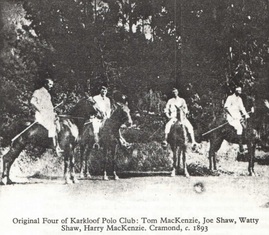 The Karkloof team from 1899 to 1914 was made up of the four Shaw brothers, having been joined by younger brother Campbell. This team had the unique distinction of never having been beaten for the duration of this period. Some feat considering they encountered the best teams in South Africa. Scott-Shaw tells us "It was generally agreed among British military officers that the Shaw brothers team would have beaten any club in the world at that time. They conquered visiting teams from India with championship honours.....They beat the 7th Hussars in the Beresford Cup and three months later the 7th Hussars won the British Army Polo Championship in England" And all of this on colonial poines bred and trained by themselves. Such was the fame of the four Shaw brothers that a poem was written in their honour Here, the great team of polo players rose: 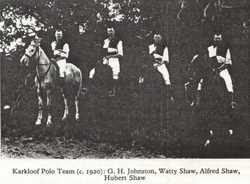 "Who does not remember the famous Shaw brothers and their unbeaten record?. Lean wiry, farmer-men who put the 'swanky' military teams to shame in many a hard fought game. The military-men would turn out with their beautifully groomed expensive ponies and the team from the bush country, with their wiry, nippy little mounts, would defeat them time and time again. Perfect combination and perfect understanding of each other's play used to win the day for the famous four." ConclusionThe third daughter of George & Grace married Frederick William Morton and had five children. John Trotter's other daughter Grace Elizabeth married Harold Stanley Stiebel in 1902 and must have had at least one son as I can find a record for John Trotter Stiebel. Reading Charles Scott-Shaw's book has been an enlightening experience and I hope you don't feel I have over glamorised my interpretation. As well as the fun and success, there was great hardship, suffering and loss, as I suppose there is, and always has been throughout the world. I have merely extracted a few of the high moments & events. I am so full of admiration of the foresight and fortitude of all of those settlers who stuck it out and made a go of it! I am delighted to say that I am now in contact with the widow of Wattie Shaw's grandson, and am enjoying hearing what present day descendants of George & Grace are up to! So if you are reading this and are another descendant, and I am sure there will be many, I would dearly love to hear from you! If anyone has questions about the Trotter family pre emigration, and the fate of those that remained in the UK I will be delighted to answer them. I wish you all a very Merry Christmas & a Happy & Prosperous New Year!
23 Comments
|
AuthorSusie Douglas Archives
August 2022
Categories |
Copyright © 2013 Borders Ancestry
Borders Ancestry is registered with the Information Commissioner's Office No ZA226102 https://ico.org.uk. Read our Privacy Policy
